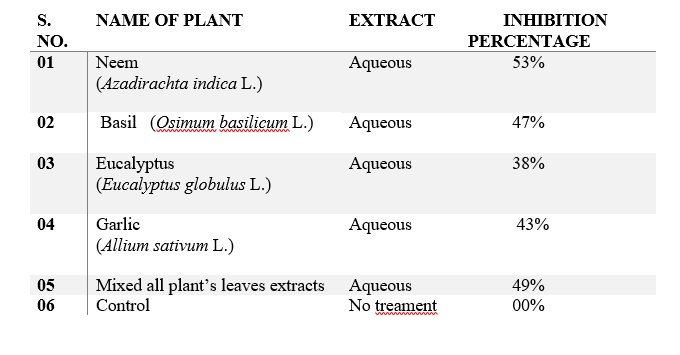SUSTAINABLE CONTROL OF TOMATO LEAF BLIGHT DISEASE CAUSED BY ALTERNARIA ALTERNATA AND CURVULARIA LUNATA IN DISTRICT KAMBER SHAHDADKOT, SINDH, PAKISTAN
Keywords:
Fungicides, Azadirachta indica, Osimum basilicum, Meliaceae, tomato, basil, eucalyptusAbstract
Family Solanaceae has achieved illustrious value in the world because of its supreme plant members. Tomato (Solanum lycopersicum L.) has the credited with second pillar of the family. It is cultivated throughout the world for fresh fruits and different processed products. Fungi are most common pathogens on tomato plants. They cause number of diseases like early and late blights, leaf molds, and septoria leaf spot. To control these fungal diseases fungicides are used by people for a long time. From the one side these fungicides control or reduce the fungal infections but from another side they create health and many environmental problems. Present attention has been targeted on the use of natural products of plants origin as proxy to laboratory prepared fungicides. The natural plant extracts are not only effective but also safe to human health and are biodegradable.
To avoid the problems caused by fungicides natural control of fungal diseases through various botanical extracts has been applied. In vivo use of plant leaves extracts shown significant results against growth and development of fungal mycelia on tomato plants. The research was presided over to study the antifungal activity of various plant leaves extracts i. e. neem, basil, eucalyptus and garlic beside fungicides. Total five aqueous solutions of plant extracts were prepared and tagged with ABC letters. The tomato plants were cultivated in six field plots of 4 by 4 meters. The selected fungi members i.e. Alternaria alternata and Curvularia lunata were inoculated on one month old fresh leaves of tomato plants of respective plots. Having infections started the treatments of various extracts were sprayed time to time up-to fruits ripening while the plants of control plot were left free. At the over the course of experiment, aqueous extract of neem tree leaves expressed highest control 53% followed by the basil 47%, garlic 43% eucalyptus 38%, mixed 49% comparatively against controlled plants. Apparently the fungi shows difference in its response to the different concentration of extracts but subsequently growth inhibits with the increase of concentration.
This study aim to examine the antifungal properties of different plant leaves extracts, to make the tomato fruits safe and protect the land from effects of various fungicides
Downloads

Downloads
Published
Issue
Section
License
Copyright (c) 2024 Qurban Ali Magsi , Gul Hassan Shaikh, Maria Khan Pathan, Sahib Ghanghro, Shoukat Ali Soomro, Shoukat Ali Wassan (Author)

This work is licensed under a Creative Commons Attribution 4.0 International License.


